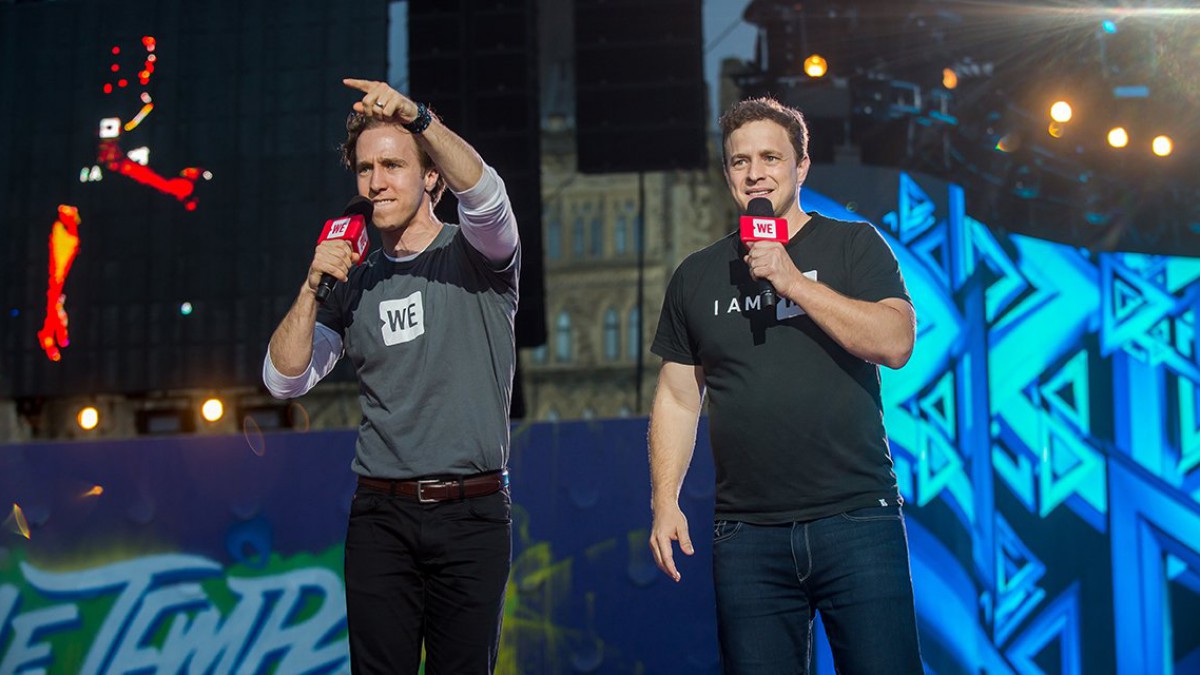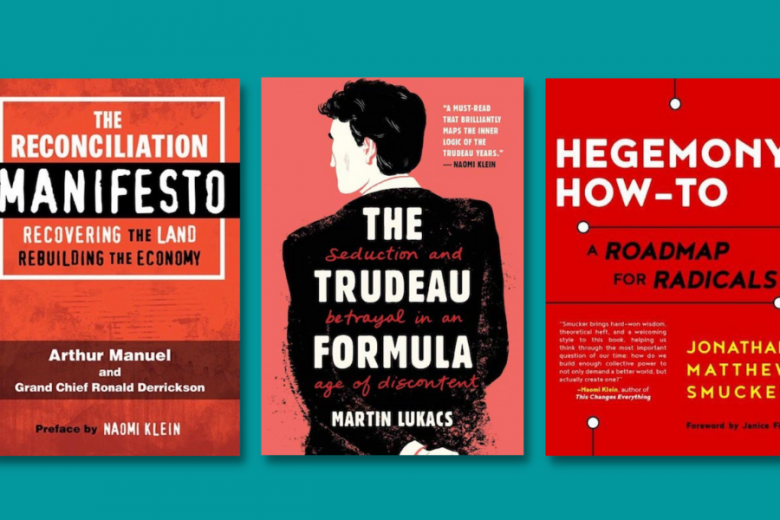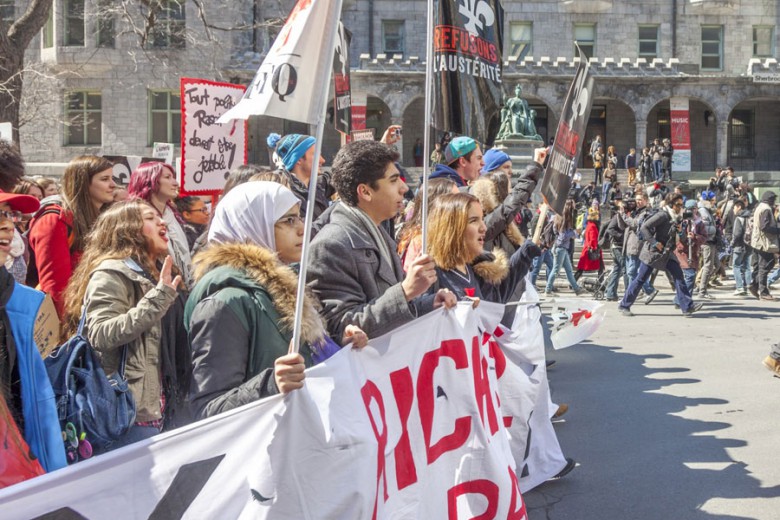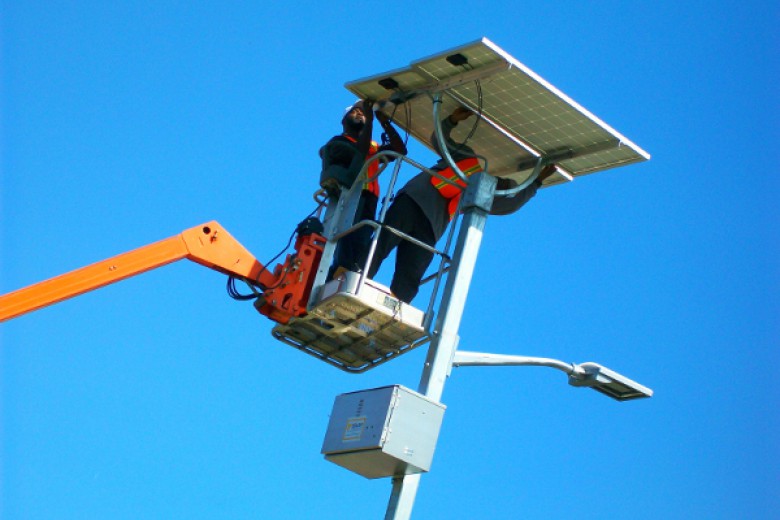On June 30, 2017, a tipi was erected on the lawn of Parliament Hill to protest the colonial celebrations of Canada 150. Across Canada that year, money was given to organizations to promote Canada’s 150th birthday, and protests in every corner contested and challenged the celebrations, reminding Canadians about the racism, colonialism, and genocide on which Canada was built. The Canada 150 confrontation cut to the core of the contradiction of Canada: strong and free, except if you are Indigenous, Black, or racialized; tolerant, but only in specific circumstances; diverse, except not in positions of power; a crusader for (or of) fairness around the world.
141 days earlier, WE Charity announced that it had partnered with the Government of Canada to coordinate a national campaign that would celebrate Canada 150 called "WE Are Canada." A central part of the work was school curriculum that was to hit classrooms across Canada in January 2017. It was coordinated through WE Schools and was supposed to focus on four main themes: “youth empowerment, the environment, diversity and inclusion, and reconciliation.” They promised to engage more than 1 million youth, raise $1 million for Canadian organizations and generate 1 million hours of volunteer work. Part of the funding included $1.5 million to host a concert on Parliament Hill on July 2, 2017.
They had anticipated 100,000 spectators for the July 2 concert. RCMP estimated a crowd of 14,000 came out.
The federal government outsourcing public education to a charity should have raised alarms at the time: what business does a private charity have developing public school curriculum, funded by the federal government?
I couldn’t find WE’s Canada 150 curriculum anywhere. Links to curriculum packs were dead and the documents I could find weren’t archived. I also couldn't find a report on the activities, if these goals were ever achieved or not. I found one poster, white with a large Liberal (or Canada?) red overlay that simply says “WE are Canada – UNIS au Canada,” made in a fake silkscreen style. I couldn’t find any proof of the 1 million hours of volunteer work or which organizations received the $1 million raised. There is a Track Your Impact website for Canada 150 that features 15 examples of children doing things, like collecting batteries, reading to other children, or purchasing WE’s famous Rafiki bracelets, but it’s doubtful that 1 million people participated in so few activities.
The federal government outsourcing public education to a charity should have raised alarms at the time: what business does a private charity have developing public school curriculum, funded by the federal government? But the whole thing was just so predictably Canadian. Who better to teach Canadian children and teens about reconciliation, diversity, and the environment than two self-made brothers who have become as much a symbol of Canada as have Tim Hortons and hockey?
As the WE scandal trots along into another week, many people are asking aloud: “why has this become the crisis that it has?” The contract at the heart of the scandal is long ago cancelled. Students who had been willing and able to work for less than minimum wage have had to find something else to do. The federal government has made far bigger errors over the course of the pandemic: from CERB being too little and covering too few people, to their role in managing Revera-owned long term care and retirement properties where hundreds of people have died. And yet, nothing has resulted in the same level of attention as WE. Why is that?
The answer is simple: Craig and Marc Kielburger have built an empire that is through to the bone an allegory for Canada itself. They have been an inspiration to Canada’s wealthy elite and offered thousands of young Canadians the opportunity to work in global development. The Kielburger brand has been key to transforming the popular understanding of international solidarity: rather than solidarity with people around the world, as Canadians, our job is to save those in need all over the world. We are called to free the children (from what? Not sure), through purchasing WE swag (sWEg?), attending field trips, volunteering in the name of WE, and doing things in Africa. The perfect prescription for Canada’s collective white guilt. And so, as every single thread connected to WE is pulled and another scandal is revealed, many Canadians watch and marvel at how one of Canada’s most celebrated organizations, and its two celebrity leaders, are coming apart so incredibly online. Sure, CERB, the Safe Third Country Agreement, Black Lives Matter, defunding the police, temporary foreign workers, and literally everything related to COVID-19 is more important, but this crisis has legs. And it has legs for the most fundamental reason: WE is a beast that only a country like Canada could create.
The Kielburger brand has been key to transforming the popular understanding of international solidarity: rather than solidarity with people around the world, as Canadians, our job is to save those in need all over the world.
Marc and Craig came to age in the same era that I did: the era where social change no longer passed through mass social movements, but instead through individual action. As a teen growing up in Southern Ontario, I had very little connection with the brothers or their work, but their message of Freeing the Children echoed throughout all social justice organizing that I saw in my high school. International development became the university program of choice for keen and progressive young people. The Kielburgers helped Canada – especially young Canadians – to reconceive of our role in helping others. They challenged us to create Me to WE clubs within high schools where we could get involved in helping other kids – but which left us with no material connection to struggles in our local communities, and offered no ways in which to continue our “activism” beyond our high school lives.
At the same time, they offered corporate and political Canada access to enthusiastic and activist youth who honestly and keenly wanted to change the world. So it’s not too surprising that the Liberal Party of Canada would see this organization as a strategic partner to attract young people to its party. Or even better, to use the platform built by the Kielburgers to promote their brand while also helping to Free the Children. The best part was that WE Charity could appear to be non-partisan, as politicians of all stripes would jump at the opportunity to perform at the Kielburgers’ main stage – a mix of evangelical mega church, Tony Robbins feel-good infomercial, and annual JUNO Awards party. Saving Children around the world isn’t simply a Liberal ideal, though it overlapped best with the Liberals’ brand of neoliberal social and economic policy: positive, nondescript work somewhere in the world, with little to show for it and no impact on or confrontation to the foundations of what creates global inequality and injustice.
WE has long offered the corporate world much what it offers political parties: direct access to young people and activities for them to launder their corporate profiles.
It wasn’t just politicians. The WE Charity also attracted a who’s who of corporate partnerships: free publicity through Jim Pattison Group, a billboard company owned by one of Canada’s richest men; free flights to send “kids and staff” to WE Day from WestJet; free meals from Freshii for staff during meetings; free phones and telecom services from TELUS; free hardware and software from Microsoft; and free financial advice and strategy services from KPMG. And anti-union Goodlife, which refuses to pay their personal trainers a living wage, gives WE staff free access to the gym. WE justifies these partnerships like this: “We believe that corporate-charity partnerships can positively help influence both the for-profit and non-profit sectors to achieve greater social good and change the world.”
Good words that ring totally hollow when you consider the damage that many of these companies to do the public good. It is literally impossible for many of these organizations to be engaged in good citizenship while at the same time extracting as much profit as they can from their employees and customers. For example, the major telecoms fight hard to keep the cost of telecommunications services unreasonably high, and the big banks that WE partners with (like RBC) make billion-dollar profits off Canadians through user fees and paying low taxes.
There are also scant details about what happens after a program or promise is announced. One partnership between WE and Chartwells promised to “unlock” 1.4 million meals through selling something called the WE Special. Chartwells is one of Canada’s largest providers of campus food. Through selling the WE Special in Chartwells cafeterias, student money was “contributed to the pledge to enable 1.4 million meals in WE Charity’s partner communities globally.” Chartwells is owned by the UK-based multi-billion-dollar company Compass Group. In their 2019 annual report, they don’t list any donations made to WE Charity, or any partnerships with them either, despite there being a robust section on corporate social responsibility and the charity work that the company engaged in the year prior. If student money was being raised by Chartwells, given to WE and sent overseas to “unlock” food for people, you would think there would be more information released by WE about how, where, and when these meals were provided.
Marc and Craig came to age in the same era that I did: the era where social change no longer passed through mass social movements, but instead through individual action.
WE has long offered the corporate world much what it offers political parties: direct access to young people and activities for them to launder their corporate profiles, especially through strategic partnerships with companies like Chartwells that rely on having a positive image among young people. Simon Fraser University’s student newspaper The Peak quoted a Simon Fraser senior administrator who referenced the Chartwells-WE program as part of why it’s good news that Chartwells took over several food services outlets on campus in 2019.
This mix of corporate and political action under the guise of progressive social activism is what underpins progressive capitalism. It’s intended to confuse average people who may be price-gouged in their flights, but who then see that WestJet is a big supporter of Freeing the Children. It fits hand-in-glove with the Liberals’ pro-corporate agenda and their progressive rhetoric.
But the questions remain: what does WE actually do? Whose lives does WE Day materially improve? How much of this octopus of organizations and corporations is sustaining a myth, and how much is it actually helping people?
The answers are part of why this scandal is still in the headlines. Every new revelation calls into question the work that hides behind the hype. They received increasing amounts of money from the federal government to implement various programs. By the time that Canada was locked down under quarantine, they had received more than $5 million. It wasn’t too much of a stretch to imagine them bidding on and winning a massive contract to administer a program that was premised on several important modern Liberal beliefs: students don’t deserve to be paid as much as average people and students need to volunteer to “give back” to their communities and relief. You can see these assumptions woven into all Liberal student programs – from tuition fees that have doubled and tripled in 10 years, to an obsession with financing students’ lives through debt.
On January 4, 2017, as the WE are Canada curriculum was being rolled out as part of the Canada 150 celebrations, the Government of British Columbia announced that it was giving $200,000 to WE Charity to be able to offer access to WE’s WE are Canada curriculum to students in British Columbia’s public schools. The curriculum had been announced months earlier, as part of the federal Canada 150 partnership. There was no mention that the curriculum, which then-minister of Canadian heritage Mélanie Joly said would reach “more than 6,000 Canadian schools,” would not be implemented in British Columbia. Indeed, it seems that WE was paid twice to develop the Canada 150 curriculum.
Just three years later, the curriculum has been scrubbed from the WE Charity website, odd considering that it was funded by government money, and, I assume, could have been implemented in other years (without a focus on the 150th anniversary of Confederation). But as with so many things related to this charity, public money seemed to flow based on good words and promises. It offered the Liberal government another location to justify and promote their pet project. It maybe created what it was intended to create, but a total lack of transparency and accountability for the use of government funds calls into question the program itself.
WE fascinates Canada’s white establishment in the same way that it mirrors it: good intention layered upon good intention, woven through a complicated web that makes it impossible to know exactly what part of the hype is true, and how much of it is pure grift.
Fast-forward three years from 2017 and the plan to pay WE to administer a sketchy and problematic student volunteer scheme finally blows the lid off this charity, whose ubiquity allowed it incredible access to average people to sell a neoliberal image of aid that fulfills a brand exercise that sells Canadian identity back to white Canada, especially to political or corporate Canada.
The road to hell is paved with good intentions and there are no more well-intentioned people than Canadians, Canadians will say. White Canadians tell ourselves that being kind and helping others is in our blood, even if our actions cause harm. WE fascinates Canada’s white establishment in the same way that it mirrors it: good intention layered upon good intention, woven through a complicated web that makes it impossible to know exactly what part of the hype is true, and how much of it is pure grift. And rather than question this, Canada’s business and political establishment were happy enough to ride along, participating in the grift, hoping to absolve itself from our collective white guilt.






_780_520_90_s_c1.jpg)
